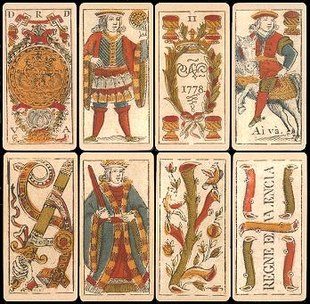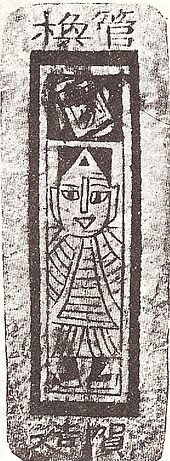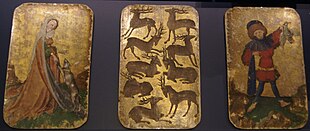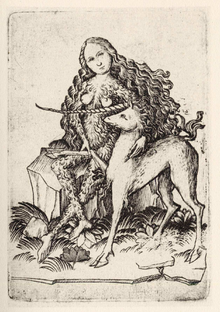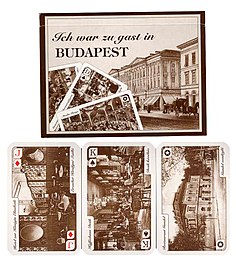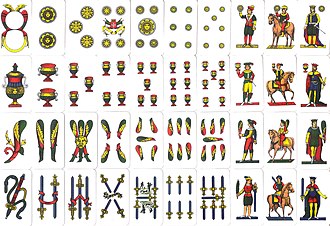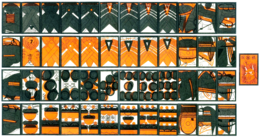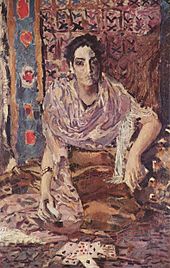Playing card
Playing cards are usually rectangular, manageable pieces made of cardboard or stiff paper , more rarely plastic , which show values and symbols on the front (obverse), and are blank or have a uniform motif on the back (lapel), so that the value of the card turned upside down is not recognizable. Each card is determined by two parameters: a value and a symbol called a color . The card values are both numbers and figures such as B. the king; mostly there are a total of 13 values in hierarchical order. Card sets usually have four suits, but their names and designs differ depending on the cultural area. A full set of cards therefore consists of 4 × 13 = 52 cards; but many card games only use a part, e.g. B. 4 × 8 = 32 cards. By shuffling a deck of cards, chance comes into play; the neutral back of the cards obscures information, making games with imperfect information possible. When they were first introduced in Europe, playing cards were the first and only game medium with these properties.
Modern playing cards usually show their suit and their value in two opposite corners or in all four corners, so that the card can be identified even if the majority of the card is covered. The remaining area of the map can be simple, but also offers space for artistic design. The motif on the front is often point-symmetrical so that the cards can also be read "upside down". The usual card sizes in the western world are around 6 × 9 cm for a standard card set or 4.4 × 6.7 cm for a solitaire game.
history
Playing cards have their origins in East Asia , where the production of cardboard tiles started earlier than in Europe. Printed paper sheets were made in China as early as before the birth of Christ and initially served mainly mystical purposes. The earliest playing cards can be found in Korea and China in the twelfth century. It is not known which games were played with these cards. Based on early illustrations, it can be proven that the cards were originally folded and not fanned, which means that initially only games of chance and no combination games were played. Playing cards made their way from China to India and Persia, as well as to the Arab countries, and finally came to Europe, where they were initially known in Italy and France. In Italy they are attested from the 14th century. In India they played with round cards, in China with more elongated, narrow strips.
History up to the 19th century
Exactly how the card game came to Europe is not certain. There is the assumption that it was imported from the Orient by the Arabs , Egyptians or via traveling people , but there is also the possibility that an independent development in the West took place on the basis of observations of this pastime in the Orient . Francesco Petrarca (1304–1374), Giovanni Boccaccio (1313–1375) and Geoffrey Chaucer (1342 / 43–1400) report on various games in their works, but do not mention card games, presumably because they were not yet familiar with them. There is evidence of playing cards in Europe only since the last third of the 14th century; in the following decades, according to sources, they spread rapidly from south to north.
As the earliest mention of playing cards in Europe, some researchers cite a ban on card games for the city of Bern in 1367, although this evidence is dubious. Only a Florentine ban of 1377 is generally recognized. The treatise by Johannes von Rheinfelden also dates from 1377 , in which he describes playing cards and interprets them morally. From this year on there are also several mentions (mostly bans) of playing cards.
The rapid spread of the card game, its connection with money stakes and the associated increase in gambling debts promptly gave rise to urban authorities who often reacted with restrictive game regulations and also prohibitions (mostly in a relatively mild form, occasionally more violent; dice, for example, became clear pursued more strictly than card games). More intense persecutions are associated with the names of particularly fanatical monks, among them Bernardine of Siena (1380–1444), Johannes Capistranus (1386–1456) and Girolamo Savonarola (1452–1498), who generally had games burned at the stake along with other reprehensible trinkets ; Capistranus proved to be particularly problematic for German playing card production , since he preached in Germany between 1453 and 1456 and made it impossible for even the very numerous card makers in Nuremberg to earn a living for a few years.
The suppression of the game varied from place to place and also from time to time, and decreased over time. As far as documents are known, it can be concluded that there were fewer bans in Germany and France than in Italy. Most of the older playing cards have been hand-painted; These were a luxury reserved for the nobility , and these cards were particularly valuable and were therefore kept more easily. One of the oldest European games is the Stuttgart card game (dated 1427–1431), comes from the Upper Rhine and shows hunting scenes of the court society. It shows the four colors of duck, falcon, dog and deer. The leaves painted on a gold background measured 19 × 12 cm. Cheaper games only had a chance to reach our time when people began to incorporate misprints of the playing card images into book spines as inexpensive reinforcement.
It was spread more quickly to the general public when cards could be reproduced using the woodcut technique, making them inexpensive to produce in series. The production of playing cards is probably the beginning of the development of the woodcut. The so-called court office game , which was created around 1450, is the oldest printed and subsequently colored card game that has been preserved to this day. Due to its symbolism, it is assumed that it was created in the courtly environment. Cardmaker guilds are known from this time in German-speaking countries from Nuremberg , Augsburg , Ulm and Strasbourg . In Austria, Vienna was an early starting point for playing card production.
In Italy, so-called Trionfi cards developed, which in some stages of development developed into the French tarot , the German tarot and the Italian tarocchi game (documented for the first time under this new name in 1505). The beginning of this development was probably in the courtly culture of the Visconti family in Milan (see the Visconti-Sforza-Trionfi cards ) and the Este in Ferrara (around 1440). The term Trionfi later led u. a. to the German term "trumpfen", which is still used in card games. The colorful Visconti-Sforza tarot, created around 1450, contains additional cards with a trump function in the game compared to the normal card sets .
In the early days - as far as it can be seen from the documents - the production processes were simplified, especially in Germany, which made playing cards an export item. As a result, woodcut, copperplate engraving and letterpress printing developed earlier in Germany than in other countries. In addition, Lyon in France developed a central role in card game production around 1500 and made card games its export hit - the result was a dominance of the French color system, which still prevails. Playing cards were given the colors cœur (“heart”), pique (“lance”), trèfle (“clover leaf”) and carreau (“square”), which are still in use today .
Until the 15th century, the map sheets were characterized by images and depictions of court life, the life of soldiers and the traveling people. Since the 15th century, today's usual card values in the form of numerical values from one to ten and the image values jack ( lower ), queen ( upper ) and king have been used. In the 16th century, regional color sign systems with four color signs emerged in Europe, which replaced the animals, flowers, coats of arms, helmets and other colors that had been common up until then. The most important leaves were the French leaf with clubs or clubs , spades , hearts and diamonds , the German leaf with acorns , leaves , hearts and bells, and the Spanish-Italian leaf with sticks, swords, goblets and coins .
From the 16th century, card games were cultivated in the gaming rooms of higher social circles. Many well-known card games originated in France and spread to Germany and other regions from the 17th and 18th centuries, including Bassette and its further development Pharo as well as Piquet and L'Hombre . At the end of the 18th century the modern double-headed playing cards came up and from the 19th century the backs of the playing cards were also printed, whereby they were marbled with early cards and later with dot and line patterns and finally with the Scottish plaid that is still common today . At this time games like skat , whist and bridge were developed, with canasta and rummy following in the early 20th century .
Fiscal interest later gave birth to the playing card tax. Pure games of chance with playing cards, such as poker and blackjack , were finally banned by the state and only allowed in casinos under state supervision . In Germany, from January 1, 1900, the Civil Code stipulated that gambling debt was not enforceable (Section 762 BGB ), unless it was based on government approval. Gambling debts were considered debts of honor.

History from the 20th century
The playing cards common today are likely to be derived from the 4 × 13 sheet with 52 cards, which was already known to Johannes von Rheinfelden in 1377, a sheet of 10 payment cards and 3 court cards. A court card construction with three male figures (a king and two marshals) was common, but women were also known to Johannes. In this system, each card has a numerical value and one of four suits. Thus, in the complete hand with the numerical values 1 (= ace) to 10 plus the three court cards, there are a total of 13 cards per color, i.e. a total of 52 cards per game set or hand. The name Ass is derived from the Latin as , the smallest currency unit in the European Middle Ages.
In the first half of the 20th century, playing cards in Germany were mainly produced in Altenburg and Stralsund . After the Second World War , production was relocated to Leinfelden-Echterdingen near Stuttgart . In Altenburg, the VEB Altenburger Spielkartenfabrik with the brand "Coeur" was created under the state management . The two companies were reunited in 2002 by the new Belgian owner Carta Mundi as ASS Altenburger . The companies Dal Negro in Treviso (Italy) and Piatnik in Vienna are today, alongside ASS Altenburger, among the largest and best-known European playing card manufacturers.
The German Playing Card Museum in Leinfelden-Echterdingen today has an extensive collection of historical playing cards. The collection was acquired from the traditional playing card factory that was located there. Another extensive collection is in the Castle and Playing Card Museum in Altenburg.
Card sheets
Several different types of playing cards are in use in German-speaking countries and internationally. In Germany and Austria, for example, the Franconian, Altenburger, Bavarian and French sheets are played, and in Austria the tarot sheet is added. In Switzerland, on the other hand, the French newspaper and the Swiss newspaper known as the “German newspaper” are common. There is a cultural border that runs through the middle of the canton of Aargau: to the east of it the German sheet is common, to the west of it the French one.
French sheet
The French leaf has the color values:
|
Cross (meeting point) |
Spades | heart | Diamonds |
| Trèfle | Pique | Cœur | Carreau |
|
|
|
|
|
The card symbol of the color cross is a shamrock. The original French name for it is trèfle "clover". Based on this, the color in Austria is referred to as a meeting point , which can be proven as early as 1776 in Strasbourg in Alsace . Possibly it was believed that the final syllable -le in the previously common Treffle was a diminutive. It is more likely that the end syllable, which is almost silent when speaking quickly, was simply ignored. The color of spades is colloquially called Schippe in the Rhineland , but in the German-speaking regions of Switzerland and in some regions of southern Germany it is called Schaufel ( Schuufle ). The color diamond is called corners ( harrow ).
The card values range from one ( ace , A) to ten and are then set with the court cards jack or page (B or V for French valet "servant, servant"), queen (D, French queen , or Q for English Queen ) and König (K and R for French Roi ) continue. That makes a total of 52 cards or sheets. For some games ( rummy , canasta ) these are extended by one to three jokers .
Packs of playing cards (sheets) are available in stores in the following common combinations:
- Rummy - Bridge - Canasta: 2 × 52 sheets + 6 jokers = 110 sheets. In order to be able to quickly separate a single sheet of 55 cards (52 sheets + 3 jokers), the backs of the two sheets of 55 cards contained have different colors. Versions in which all 110 cards have the same reverse side are rarer. This hand can be used to play all common card games that do not use cards specially developed for the game. Unnecessary cards are removed from the sheet as needed.
- Patience : corresponds to Rummy - Bridge - Canasta with different colors of the two included sheets of 55 cards. The cards are significantly smaller than usual playing cards with a French face, so that you can place patience even when space is limited.
- Poker , Whist or Bridge: 52 hands. Occasionally, the hand is also accompanied by three jokers, with which two of thesehands can be combinedto form a Rummy - Bridge - Canasta leaf.
- Baccarat 6 × 52 sheets. The cards do not have any index marks and have single-color backs without a pattern.
- Skat : 32 hands, card values in the order from bottom to top 7, 8, 9, queen, king, 10, ace, above the four jacks diamonds, hearts, spades, clubs.
- Jass or Durak : 36 hands, card values 6… 10, jack, queen, king, ace.
- Double head : 2 × 24 hands = 48 hands, card values 9, 10, jack, queen, king, ace, with each card being duplicated. Occasionally a joker is included with the sheet.
- Tarot : 78 sheets, 56 wrong suits with card values 1… 10, jack, rider, queen, king, plus 21 trumps I… XXI and an excuse. The tarot sheet is the complete French card sheet and is used in more elaborate variants (e.g. with an Italian picture) for laying cards .
High-quality sheets are shrink-wrapped in a transparent film in their original packaging. This fact is used by card players often show to the other players that the game with a new, non -jointed played leaf. The cover sheet is an additional card, with the Rummy-Bridge-Canasta- sheet one card per sheet of 55 cards, on which a court card is usually shown on one side, with the Skat sheet usually the jack of clubs and on the other half-side information about the Sheet (manufacturer, type of sheet and the image used, number of cards included without cover sheet) are printed on. If the cover sheet has the same back as the other cards on the sheet, it can be used in the game, usually with the application of special rules. In the case of the Skat sheet, the cover sheet also contains a short form of the Skat rules.
In Switzerland and North America there is also a - less common - variant of the French hand, in which the four symbols (colors) are all colored differently: the cards of clubs are olive green (instead of black) and the cards of diamonds are light blue or orange (instead of red). These playing card colors are also useful in poker , as they prevent diamonds and hearts or spades and clubs from being mixed up, which can be very uncomfortable, especially with a supposed flush. These so-called four-color decks (as opposed to two-color decks ) have not become widely accepted when playing with real playing cards, but are very common in online poker at least as an option because of poor image resolution (e.g. because of playing several Tables at the same time) or fatigue make the exact differentiation of the playing card colors exhausting. In addition, it is technically possible for some players at a table to see the cards as a popular two-color deck and other players at the same table to see the same cards as a practical four-color deck.
Symbolism of the picture cards
The jack (pawn), queen and king face cards represent different historical or mythological persons:
- King of the Cross: Alexander the Great
- King of Spades: David
- King of Hearts: Charlemagne
- King of Diamonds: Julius Caesar
- Cross lady: Juno Regina (Roman main goddess and wife of Jupiter as well as patroness of marriage)
- Queen of Spades: Pallas Athene (Greek goddess of wisdom)
- Lady of Hearts: Judit ( biblical ideal of piety)
- Queen of Diamonds: Rachel (biblical figure as ideal of beauty)
- Jack of clubs: Lancelot , the knight from the Arthurian legend
- Jack of spades: Hogier ( Holger Danske ), a cousin of Charlemagne
- Jack of Hearts: La Hire ( Étienne de Vignolles ), a soldier at the side of Joan of Arc
- Jack of diamonds: Hector of Troy or Roland , a paladin of Charlemagne
Anglo-American Journal
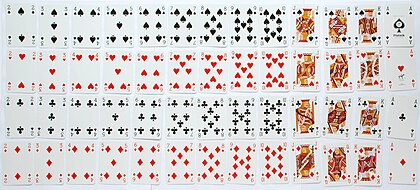
The Anglo-American sheet corresponds in color and card values the French journal, the pictures and the most part as a differ in design Schmuckbild designed Pik - Ass ( Engl. Ace of Spades ), but by this. In addition, the ladies wear the letter “Q” for Queen instead of “D” and the jacks instead of “B” the letter “J” for Jack (common name for a simple man).
The Anglo-American playing cards were the first to have index names (information on the suit and value in the corners), which, with a few exceptions ( Baccara , Écarté , Préférence and Schnapsen ) , are now common on all sheets with French colors.
A special form of the Anglo-American hand are poker cards (for the differences, see the section Differences to the Anglo-American hand ).
German sheet
|
Acorn Eckern cone cross |
Foliage Green Grass Spade Leaf Shovel Blue |
Heart red |
Bells Karo Bollen |
|
|
|
|
|
The German newspaper knows the colors acorn , leaves , heart and bells . The names for the different colors sometimes have significant regional differences (for alternative names, see graphic). In addition to the cards with numerical values, there are the four image values Unter (also Bauer), Ober (also Dame), King and Daus or Sau (possibly due to the pig on the Schell-Daus on the sheets of the Salzburg or simple German image and the Bavarian image ) . In most of the variants in use today, the card values range from 6 to 10 as well as Unter, Ober , König and Ace. Around 1500 a pig was depicted on each of the four houses in the Ulm-Munich picture . The dhow is often executed as an ace. The name Daus is derived from franz. deux or Latin duo from: The dhow was originally the two and not the one; in the Salzburg or Plain German and in the Swiss newspaper this is still preserved in the representation. In Swabian the dhow is often referred to as "old". The cards with the value 6 are only used in a few games. In some games, the Weli is used as a joker. The waiter is probably derived from the knight of the tarot sheet.
The German newspaper is divided into many regional versions, which differ in different details of the color symbols and especially in the drawings of the farm cards and the sow. There are e.g. B. Old German, Swiss German, Bavarian, Franconian, Saxon, Salzburg or Baden papers. The Württemberg sheet follows the theme of the German sheets, is based on the French sheet for the kings and assigns them the same attributes (scepter, apple, harp).
Many popular card games use a further reduced hand, whereby the small number cards ( called Luschen , Schwanzal or Spatzen in the jargon of card players ) are omitted. In the extreme case, the short Schafkopf only has the card values 9, 10, Unter, Ober, König and Ace, with the very short one there are also no nines, similar to Schnapsen , the hand is reduced to 20 cards. The order in which the cards are valued can also be very different. Other games double a possibly reduced hand. For example, Doppelkopf is played with two short sheep's head blades, i.e. 2 × 24 blades = 48 blades.
The color assignment between the German and French sheets takes the following form:
| German sheet | Acorn | leaves | heart | Ring |
|---|---|---|---|---|
| French sheet | cross | Spades | heart | Diamonds |
Different cards have their own names, so the king of hearts is also called "Max", possibly as an allusion to the Bavarian King Maximilian. In Thuringia and Saxony, the Eichel-Unter (Kreuz-Bube) is often referred to as "Alter".
Hungarian / Central European / Double German sheet
In Austria, Hungary, Slovakia, Slovenia, Croatia, parts of Bosnia and parts of the Czech Republic, a sheet is in use that uses the same colors as the Bavarian sheet and is illustrated with personalities from the Wilhelm Tell saga (see picture) .
The Tell card was created at the time of the Hungarian uprisings against the Habsburgs: In order to circumvent the censorship that would have prevented the illustration of leaders of the uprising, they resorted to the Wilhelm Tell saga, which also started an uprising against the Habsburgs Subject has. Friedrich Schiller's play Wilhelm Tell was in 1827 in the Transylvanian Cluj (, Romanian Cluj-Napoca Hungarian Kolozsvár) have been listed. In 1974 the oldest of these cards were discovered in an English private collection, on which the data was also found: “To be found at Joseph Schneider in Pesth.” In Austria this sheet is known as double German - in contrast to the Salzburg or simple German sheet. Interestingly, despite the illustrations with personalities from Swiss history, this sheet is almost unknown in Switzerland.
Unter, Ober and Daus of each color each show a certain person (Unter, Ober) from Friedrich Schiller's Tell drama or a season (Daus). These are:
-
heart
- Below: Werner Stauffacher or Kuoni, the Shepherd
- Upper: Hermann Gessler
- Daus: Spring , a young woman picking flowers
-
Ring
- Under: Arnold von Melchtal or Itel Reding
- Upper: Stüssi, the hall contactor
- Daus: Summer , a young woman with a sickle mowing hay
-
green
- Below: Walter Fürst
- Upper: Ulrich von Rudenz
- Daus: Autumn , two boys who process grapes
-
Acorn
- Under: Rudolf Harras
- Upper: William Tell
- Daus: Winter , an old woman who carries firewood
Since the game Sixty-Six or Schnapsen is played partly with French and partly with German cards, German-French cards are used in tournaments , these are divided in the middle and show the German image in one half and the corresponding French image in the other half. so z. B. Shell Ober and Queen of Diamonds.
In the Bavarian Schafkopf , the individual cards have special names, for example the old one for the acorn upper, the blue one for the leaf upper, the fox for the heart upper, the old one , the blue one and the bumpel for acorn, leaf and and Schell-Ace, the latter also called a pig . Furthermore, green , grass or leaves by leaf.
Altenburg sheet
The Altenburger Blatt, distributed by ASS Altenburger , is a slightly modified German paper that emerged from the Saxon image. It consists of exactly 32 cards for use in Skat . The card values range from 7 to 10, as well as Unter, Ober, König and Ace. The color values are identical to the German sheet, their design differs slightly (e.g. the acorn is colored red, slightly longer and more angular, green or leaf looks green, bell symbol is more decorated). A variant with women instead of the upper is also offered. The under this variant have the corner sign B for jack.
The Altenburger Blatt was designed in the 1960s by the graphic artist Walter Krauss (1908–1985) from Rodewisch for the state-owned company Altenburger Spielkartenfabrik and marketed as Neue Altenburger Spielkarte in the GDR . Today it is traditionally widespread in central Germany , so it is played roughly in the state borders of Saxony , Saxony-Anhalt and Thuringia .
Bavarian sheet
The Bavarian image developed into different types from around 1650. The upper and lower fight in all variants, accompanied by the grass upper and lower with a drum or whistle. Bavarian maps have an aspect ratio of roughly 2: 1. In the simple image that was common in the past, this was mainly used on the number cards for various visual representations. The only pictorial representations can only be found on the doubles (two, sows or incorrectly aces).
Variants still in use today are:
- Bavarian-Swabian picture
- Bavarian double image, Munich type
- Bavarian double image, Stralsund type
- Single images of today's double images
- Franconian double image
- Bohemian image
- Salzburg picture (also simple German picture)
Variants that are no longer used today are:
- Old Bavarian image (common forerunner) with variants in Poland and Russia
- Isarkkreis picture (forerunner of the Salzburg picture)
- Nuremberg eagle (coat of arms) map
- Regensburg image (forerunner of the Bohemian image)
- Tyrolean picture
The Augsburg picture
The archetype of today's Bavarian newspaper is around 1500 next to the Ulm-Munich picture, the Augsburg picture . The four kings sitting on thrones are each accompanied by two servants wielding weapons. Upper and lower of the color grass are military musicians, the upper is a bagpipe-playing fool, the lower is playing a fanfare or flute. Upper and lower hearts fight with polearms, upper and lower bells with a sword, upper and lower acorns with maces and a humpback shield.
The old Bavarian image
From the middle of the 17th century, after the Thirty Years' War, the Augsburg image changed to the so-called old Bavarian image . Acorn upper and lower now fight with sword and parrying dagger. Grass top and bottom now play with drum and pipe; From now on, drummers and whistlers are the hallmarks of the Bavarian image. Top and bottom of the same color fight against each other with the same weapons, like in a fencing school. During this time, the number of cards, probably due to a lack of paper, was reduced from 48 (the one - ace - had already disappeared before) to 36 cards (three, four and five disappear, two - doubles - was already higher value than that at that time King). At the end of the 17th century, during the Turkish Wars, grass and acorn kings exchanged their crowns for turbans. The dhow cards show a pyramid of unicorn, deer and eagle on the grass dhow, Bacchus on the acorn dhow, a wild boar with a hunting dog on the bell dhow and usually a Cupid on the dhow dhow. Around 1750 this image was widespread throughout the entire Bavarian settled area. Smaller versions of this image were common in Congress Poland until 1918.
The modern Bavarian image
In the newly created Kingdom of Bavaria, the old Bavarian image changed to the modern Bavarian image after 1810 . A vase now appears on the grass dhow, the acorn king receives a crown again - the grass king remains the only "oriental". The upper-heart exchanges his polearm for a sword, which he leans on. Acorn upper and lower each receive only one weapon, the acorn upper also has an oval shield. This type, created by the Munich card maker Josef Fetscher, is known today as the Munich type of the Bavarian picture in the drawing by the Frankfurt card maker "CL Wüst", which was made around 1854, and was widely used by the "FX Schmid" playing card factory.
From 1882 the United “Altenburger and Stralsund playing card factories” printed their own version of the Bavarian image, which was based on a card image from the Frankfurt card factory “Lennhoff & Heuser”. The kings, upper and lower, are dressed in fancy uniforms in the style of historicism. The main distinguishing features of this Stralsund type of the Bavarian image from the Munich type are:
- The grass waiter carries his drum on his right knee instead of his left.
- The acorn-under receives a beret .
- The acorn upper has a pointed shield instead of an oval one.
- The Bacchus on the acorn dhow has a beer mug instead of a wine mug.
- The Cupid has butterfly wings.
In the 20th century, the number and figure cards were gradually given index marks, and finally the “A” was incorrectly used instead of the correct “D”. After the Second World War, the previously dominant single image finally disappears and is replaced by the double image that is still widespread today.
Franconian sheet
The Franconian sheet consists of 36 cards: acorn, green, heart and shell each as ace, king, upper, lower, 10, 9, 8, 7 and 6. It differs in design from the Bavarian sheet. It was created after 1840 from the Munich type of the Bavarian image.
The ace of bells and hearts are relatively simple, the green ace shows an eagle and the acorn ace a lion.
French sheet with German colors
| cross | Spades | heart | Diamonds |
|
|
|
|
|
The French sheet with German colors is the official tournament sheet of the International Skat Rules for Skat . It is a sheet that uses French symbolism, with the colors of the symbols not being black and red, but black, green, red and yellow ( four-color sheet ).
This variant was created after the reunification of Germany, as the French sheet was used in West Germany and in the north of East Germany, and the Altenburger sheet in the south of East Germany. In order to unite the two players' associations, this compromise was agreed at the 25th Skat Congress in 1990 .
Swiss sheet
| Acorns | Shields | Roses | Ring |
|
|
|
|
|
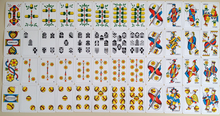
The Swiss national game Jass uses a variant of the German cards with 36 cards, the so-called German-Swiss cards , east of the Brünig-Napf-Reuss line . They consist of the colors acorns, reeds, roses and bells. The values are six to nine, banner, under, over, king and ace (also sow or doubles). The shields correspond to the color green, the roses to the hearts; the four banners to the tens.
West of the Brünig-Napf-Reuss line and in Graubünden, Jass is played with French cards (36 cards per game: 6 to 10 each, jack (as trump suit: pawn), queen, king, ace); Diamonds are called "corners", spades "shovels". In the Jass programs of Swiss television , French cards are used in four (instead of two) colors: cross in green (instead of black) and corners (diamonds) in blue (instead of red), hearts as usual in red and shovels (spades) in black. These cards are also sold in department stores and are designed to make it easier for beginners to tell the colors apart.
The color assignment between the Swiss and French sheets is common in the following form:
| Swiss sheet | Acorns | Shields | Roses | Ring |
|---|---|---|---|---|
| French sheet | cross | Shovels | heart | Corners |
Tarot sheet
The tarot sheet in use today knows the same colors as the French sheet: hearts , diamonds , spades and clubs . The card values used are: 7 to 10, jack / page, knight / rider, queen, king. In some variants, the values 4, 3, 2 and 1 are also used as number cards for the red colors of hearts and diamonds. In addition there are the “Tarock”, which are picture cards with consecutive numbering from I (Pagat) to XXI (moon, wrongly for French. Le monde , the world) and the Sküs (s). This makes a total of 54 cards. In most variants of the game of Tarock, these cards have the function of the trump suit; the Sküs (s) also overtakes all other tarots.
There are also many regional versions of the tarot sheet, which differ in the design of the courtyard cards and the images on the tarot cards.
Italian-Spanish sheet
The Italian-Spanish sheet has the colors
The card values range from Asso / Ace (one) to seven or to nine and then continue with the face cards Fante / Sota (jack, soldier), Cavallo / Caballo (rider) and Re / Rey (king). Although the face cards begin with the number ten, cards eight to nine are rarely used, so that there are packets of 40 instead of 48 sheets.
A variant of the Italian-Spanish card is the Trappolierkarte (based on the Trappola card game ), this was particularly widespread in Silesia , so that they are also called Silesian playing cards . The king is called "the deer " after the Italian Re ; the number cards are ace, two, seven, eight, nine and ten, for a total of 36 hands.
The assignment of the Italian-Spanish to the French colors is as follows:
- Spade, espadas - spades
- Coppe, copas - heart
- Denari, Oros, Ouro (Portuguese) - diamonds
- Bastoni, Bastos, Palo, Paus (Portuguese) - cross or meet
The colors of the Italian-Spanish sheet can also be found on the tarot cards used for fortune telling. (The French tarot or Austrian-German tarot playing cards use the colors of the French hand).
Other playing cards
In addition to the traditional cards, there are also other motifs from the classic and numerous card games with their own hand .
There are also so-called divination , oracle or fortune-telling cards that are used to predict the future . These can be cards specially made for this purpose or an ordinary Skat sheet . In Japan there are the traditional Hanafuda and Kurofuda .
Playing card tax
In various countries playing cards became taxable soon after their introduction and were therefore stamped by the sovereign who collected the tax or his agent. In France, for example, this tax has been levied since 1583. The playing card manufacturer printed a small white circle on the front of a specified card, on which the tax officer then put his stamp. After that, the cards could be sold. The tax was a substantial part of the selling price. In Germany, the collection of playing card taxes was a matter for the federal states until 1879. On January 1, 1879, uniform tax rates came into force across the empire. A tax of 30 pfennigs was levied for card games with up to 36 cards and 60 pfennigs for games with more cards. On November 1, 1919, the tax rates were increased significantly. They were now one mark for sheets of up to 24 cards, two marks for sheets of up to 48 cards and three marks for larger sheets. The German inflation from 1914 to 1923 also led to an increase in the playing card tax. At its peak the tax rate was 26 million marks per sheet. Accordingly, the stamps were now attached without specifying the value. After the period of inflation, the tax rate of 30 pfennigs was returned. This minor tax was abolished on August 1, 1939 .
Other use
In addition to their use in card games, playing cards were and are also used for other purposes. The use of playing cards in fortune telling in the form of fortune telling cards is particularly well-known , whereby both tarot cards and cards from other sheets, often the French Skat sheet , are used. Cards are also often used in the art of magic , with the magic of playing cards being referred to as card art . Both unprepared card sheets ( Impromptu ) and card sheets that have been specially prepared for the card tricks are used here. Another popular occupation is building card houses , using playing cards to build buildings and other constructs.
Traditionally, playing cards (mostly misprints or incomplete sentences for cost reasons or to avoid the playing card tax), slightly curved in shape, were used in the pharmacy in formulations to scrape off ointments or powder from pestle and mortar . This requires quick work as the cards soften quickly. As a substitute, unprinted plastic cards that have already been cut to size are used today, which are still called card sheets, but, unlike “real” card sheets, do not soften and are therefore reusable.
Playing card money
A use of playing cards as a money substitute is known from New France in what is now Canada . In 1685 there were delays in the payment of wages from Paris. To counter this, the then provisional governor Jacques de Meulles had all playing cards withdrawn, cut into four and printed with the governor's seal. The resulting playing card money was in circulation for more than 70 years and is now popular with collectors as a rarity.
Playing cards in opera and film
The card game is also used as a dramatic or creative element in scenes from the opera or film . At a central point, the protagonist of Georges Bizet's opera Carmen (1875), together with two other gypsies, questions the cards. The opera Pique Dame (1890) by Peter Tchaikovsky is about a hero who has fallen for Pharo . In Igor Stravinski's ballet Jeu de cartes (1936), poker cards are the focus of the action. In Nikolai Gogol's comedy The Players , a marked card game plays a central role; the piece was used by Dmitri Shostakovich as a model for an opera fragment (Op. 63).
More popular culture
A text of a song ( The Deck of Cards ), spoken rather than sung by the country singer T. Texas Tyler in 1948 , deals with the symbolism of playing cards in a religious sense. A German version appeared in 1974 under the title Das Kartenspiel , with Bruce Low .
Individual evidence
- ↑ Thierry Depaulis: colors. Playing cards and card games. In: Ulrich Schädler (ed.): Games of humanity. 5000 years of the cultural history of board games. Darmstadt: WBG 2007, pp. 73–81, here 73.
- ^ David Parlett: The Oxford Guide to Card Games. Oxford: OUP 1990, p. 15
- ↑ a b c d e f g h section "Card games", in: Erhard Gorys : The book of games. Manfred Pawlak Verlagsgesellschaft, Herrsching o. J., p. 7.
- ^ Detlef Hoffmann: Culture and art history of the playing card. Marburg: Jonas Verlag 1995, p. 43.
- ^ Peter F. Kopp: The earliest playing cards in Switzerland. In: Journal for Swiss Archeology and Art History 30 (1973), pp. 130–145, here 130.
- ↑ Timothy B. Husband: The World in Play. Luxury Cards 1430-1540. Metropolitan Museum of Art 2016, p. 13.
- ↑ Hellmut Rosenfeld: To the earliest playing cards in Switzerland. A reply. In: Journal for Swiss Archeology and Art History 32 (1975), pp. 179–180.
- ↑ Early Prohibitions of Playing Cards (Trionfi.com)
- ^ Peter F. Kopp: The earliest playing cards in Switzerland. In: Journal for Swiss Archeology and Art History 30 (1973), pp. 130–145, here 130.
- ↑ Hellmut Rosenfeld: To the earliest playing cards in Switzerland. A reply. In: Journal for Swiss Archeology and Art History 32 (1975), pp. 179–180.
- ^ Detlef Hoffmann: Culture and art history of the playing card. Marburg: Jonas Verlag 1995, p. 43.
- ^ Johannes of Rheinfelden, 1377 . trionfi.com , accessed on September 28, 2015 .
- ^ Wilhelm Ludwig Schreiber: The oldest playing cards and the documents relating to the card game from the 14th and 15th centuries . Heitz, Strasbourg 1937.
- ↑ Early Prohibitions of Playing Cards (Trionfi.com)
- ↑ map images. DSkV.de , January 17, 2012, accessed on November 25, 2013 .
- ^ Double German: Wilhelm Tell and the Hungarians. April 10, 2014, accessed September 2, 2015 .
- ^ Altenburger Spielkartenladen , accessed on April 21, 2018
- ↑ Collector shows rare playing cards , Freie Presse, accessed on June 5, 2017
- ^ Franz Braun: The playing card factory B. Dondorf. Cologne 1991, p. 20
- ↑ http://lyricsplayground.com/alpha/songs/d/deckofcards.shtml
- ↑ http://hitparade.ch/song/Max-Bygraves/Deck-Of-Cards-294614
literature
- Manfred Hausler: Drummers and Piper. The history of the Bavarian playing cards. Changed new edition. Volk Verlag, Munich 2016, ISBN 978-3-937200-89-7 .
- Detlef Hoffmann: Culture and art history of the playing card. Marburg: Jonas Verlag 1995
- Timothy Husband: The world in play: luxury cards, 1430–1540 , First printing. Edition, Yale University Press, New Haven 2015, ISBN 9781588396082 .
- Theodor Kohlmann : Berliner Spielkarten , Copyright 1984 for the Association of Friends of the Museum for German Folklore, Berlin, ISBN 3-924084-01-7 .
- Wilhelm Ludwig Schreiber: The oldest playing cards and the documents relating to the card game from the 14th and 15th centuries . Heitz, Strasbourg 1937
- Jude Talbot: Number color trump. The history of playing cards . Hildesheim: Gerstenberg, 2019
- Bibliography of Playing Card Books (English)
Web links
- German Playing Card Museum in Leinfelden-Echterdingen
- Altenburg Castle and Playing Cards Museum
- Court office game, around 1450
- Playing cards 1427–1800, many articles on the early history of playing cards (English)
- Playing card production in Altenburg ( Memento from February 22, 2008 in the Internet Archive )
